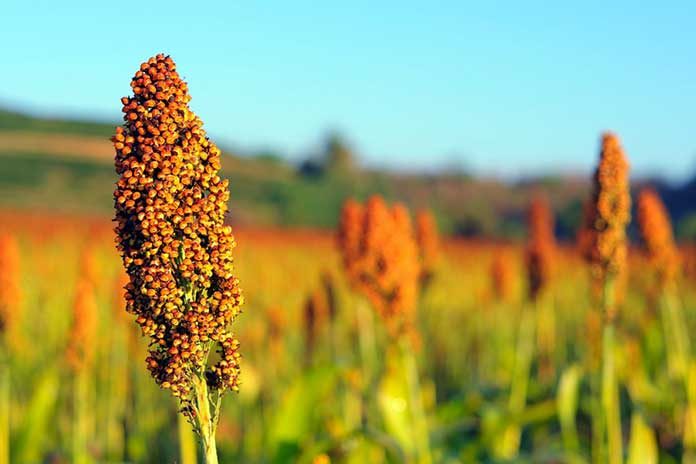
This study was conducted to evaluate the endogenous enzyme activities and energy utilization of broilers fed sorghum-based diets supplemented with phytase and carbohydrases
Broilers were housed in cages in climate-controlled rooms. The jejunum and pancreas were collected at 10 and 24 d for analysis of endogenous digestive enzyme activities. Birds were also sampled at hatch and 24 d and analysed for gross energy, fat and crude protein contents. The data were used to calculate heat production, net energy of production and efficiency of energy utilisation. There were improvements in digestive enzyme activities and utilisation of energy, in terms of metabolisable energy and net energy of production (NEp), suggesting the suitability of the exogenous test enzymes for use in sorghum-based diets.
A recent study on Australian sorghum by Selle et al. (2017) reported that sorghum produced in Australia is used almost exclusively for feed, especially cattle, pigs and poultry. The objective of the present research is to assess the response of broilers to diets based on sorghum, when supplemented with a combination of enzymes, targeting different substrates. A total of 648 male and female Ross 308 broilers was randomly assigned in a 3 × 2 × 2 factorial arrangement of treatments [3 doses of phytase none, standard (100 mg/kg) and superdose (300 mg/kg)] × 2 doses of xylanase and of β-glucanase [none and standard (100 mg/kg)] in a completely randomised design. Each of the 12 treatments was replicated 6 times, with 9 birds per replicate.
The diets were fed ad libitum from 0 to 35 days in 3 phases – starter as crumble (1-10 d), grower as pellet (11-24 d) and finisher as pellet (25-35 d). The test diets contained 60, 64 and 68% of sorghum in the starter, grower and finisher respectively and were formulated to meet the specifications recommended for the Ross 308 broilers. A sub-sample of 10-day-old chicks was euthanised by cervical dislocation, minced and analysed to provide baseline data on body composition: gross energy, crude protein and fat contents. At d 24 two birds per pen were randomly selected, euthanised by cervical dislocation and processed (chopped, minced and freeze-dried) and used to determine carcass energy, protein and fat. On d 10 and d 24 one bird was randomly selected from each cage, electrically stunned and euthanised by cervical dislocation.
These were dissected to obtain the whole pancreas and anterior jejunum (4-5 cm long) and used to determine the endogenous enzyme activities. Another 2 birds were similarly slaughtered at d 24 and processed as described for the birds collected at d 0, to determine the energy, protein and fat contents of the intact carcass. The data from d 24 were related to the baseline data obtained from the day-old broilers, to calculate the heat production (HP), NEp and efficiency of utilisation of metabolisable energy. Between d 25 and d 35 birds were fed finisher diets to measure meat parts yield. A general linear model procedure was used to analyse the collected data (Minitab Inc., 2013).
There was an interaction (P<0.003) between phytase, xylanase and β-glucanase on chymotrypsin activity at d 10. Addition of phytase increased (P<0.02) pancreatic protein content, trypsin activity and general proteolytic activity. At d 24 pancreatic protein content and enzyme activities (chymotrypsin, trypsin and general proteolytic activity) also responded (P<0.02) to interactions between phytase and β-glucanase. General proteolytic activity was increased (P<0.004) in the groups supplemented with phytase. At d 10, there was no interaction between the factors on the activities of jejunal membrane-bound enzymes but the activities of maltase, sucrase and alkaline phosphatase were increased (P<0.004) with phytase inclusion. Phytase supplementation also increased (P<0.01) the activities of jejunal sucrase and aminopeptidase at d 24. At d 24, there was an interaction (P<0.03) between phytase, xylanase and β-glucanase on apparent metabolisable energy (AME) content. The interaction between xylanase and β- glucanase on energy retained as fat and as protein and on efficiency of metabolisable energy use for lipid retention were significant (P<0.01). Addition of phytase to the diets of broilers increased (P<0.001) the NEp, AME, energy retained as fat, energy retained as protein, and the efficiency of metabolisable energy for energy, lipid and protein retention. The efficiency of utilisation of metabolisable energy for energy retention was also increased (P<0.05) with β-glucanase supplementation.
The test enzymes are suitable for use in sorghum-based diets and can be increased the enzyme activities in jejunal and pancreas. Their effects on energy use warrant this recommendation.
Acknowledgement: Authors would like to thank AB Vista, UK and UNE for providing research funds.
References:
Aviagen. (2014) Ross 308 Broiler chickens nutrition specifications. Retrieved from http://en.aviagen.com/tech-center/download/12/Ross-308-Broiler-Nutrition-Specs- 2014r17-EN.pdf?k=73ed714787d516b8d492e15ab8999943e2532b64.
Minitab Inc. (2013) Minitab® Statistical Package, Minitab Inc., State College PA, USA.
Selle PH, Moss AF, Truong HH, Khoddami A, Cadogan DJ, Godwin ID & Liu SY (2017).
Animal Nutrition 4: 17-30.
From the Proceedings of the 2019 Australian Poultry Science Symposium

















